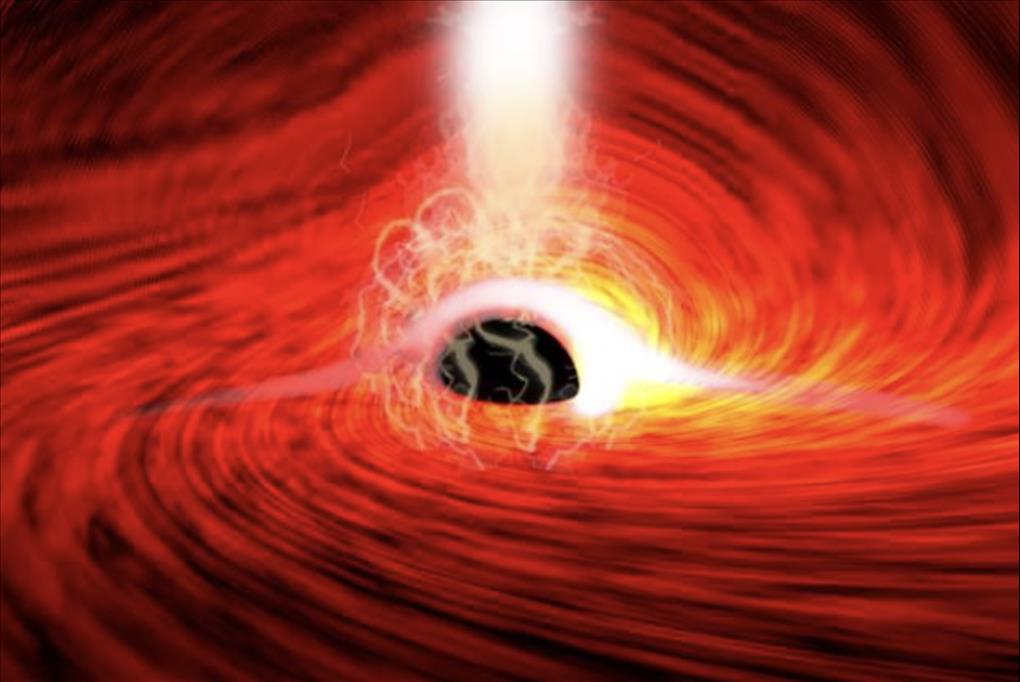
Black hole discovery backs Einstein's theory
(MENAFN- Asia Times) Yet another scenario that was predicted by Albert Einstein's theory of general relativity has been confirmed, more than a century after it was first posed.
And it all began when Stanford University astrophysicist Dan Wilkins noticed an intriguing pattern. as he watched X-rays being flung out into the universe by the supermassive black hole at the center of a galaxy 800 million light-years away.
According to a report by Taylor Kubota, of Standford News , Wilkins observed a series of bright flares of X-rays – exciting, but not unprecedented.
These bright light flares are not unusual because although light can't escape a black hole, the enormous gravity around it can heat up material to millions of degrees.
This can release radio waves and X-rays. Sometimes, this super-heated material is hurled out into space by rapid jets — including X-rays and gamma rays.
But then, the telescopes recorded something unexpected and exciting — additional flashes of X-rays that were smaller, later and of different“colors” than the bright flares.
According to theory, these luminous echoes were consistent with X-rays reflected from behind the black hole — but even a basic understanding of black holes tells us that is a strange place for light to come from.
“Any light that goes into that black hole doesn't come out, so we shouldn't be able to see anything that's behind the black hole,” said Wilkins, who is a research scientist at the Kavli Institute for Particle Astrophysics and Cosmology at Stanford and SLAC National Accelerator Laboratory .
It is another strange characteristic of the black hole, however, that makes this observation possible, and that takes us back to the great physicist himself, who released his theory of general relativity way back in 1905.
Einstein predicted that the light must bend and reflect due to the strong gravitational pull around a black hole.
“The reason we can see that is because that black hole is warping space, bending light and twisting magnetic fields around itself,” Wilkins explained.
The serendipitous discovery, detailed in a paper published July 28 in Nature , is the first direct observation of light from behind a black hole — a scenario that was predicted by Einstein's theory but never confirmed, until now.
“Fifty years ago, when astrophysicists starting speculating about how the magnetic field might behave close to a black hole, they had no idea that one day we might have the techniques to observe this directly and see Einstein's general theory of relativity in action,” said Roger Blandford , a co-author of the paper and a Stanford professor of physics and SLAC professor of particle physics and astrophysics.
Researchers weren't even looking to confirm Einstein's theory. They were originally attempting to uncover the mysteries of an odd feature of black holes known as the corona, the source of the bright X-ray light.
Material falling into a supermassive black hole powers the brightest continuous sources of light in the universe, and as it does so, forms a corona around the black hole.
This light — which is X-ray light — can be analyzed to map and characterize a black hole.
The leading theory for what a corona is starts with gas sliding into the black hole where it superheats to millions of degrees.
At that temperature, electrons separate from atoms, creating a magnetized plasma.
Caught up in the powerful spin of the black hole, the magnetic field arcs so high above the black hole, and twirls about itself so much, that it eventually breaks altogether – a situation so reminiscent of what happens around our own Sun that it borrowed the name“corona.”
“This magnetic field getting tied up and then snapping close to the black hole heats everything around it and produces these high energy electrons that then go on to produce the X-rays,” said Wilkins.
As Wilkins took a closer look to investigate the origin of the flares, he saw a series of smaller flashes.
These, the researchers determined, are the same X-ray flares but reflected from the back of the disk — a first glimpse at the far side of a black hole.
“I've been building theoretical predictions of how these echoes appear to us for a few years,” said Wilkins.“I'd already seen them in the theory I've been developing, so once I saw them in the telescope observations, I could figure out the connection.”
The black hole is about 10 million times more massive than our sun, and is located in the center of a nearby spiral galaxy called I Zwicky, 1,800 million light-years away from Earth.
The observations were made using two space-based X-ray telescopes: NASA's NuSTAR and the European Space Agency's XMM-Newton.
More observation will be needed to understand these black hole coronas and the European Space Agency's upcoming X-ray observatory, called Athena (Advanced Telescope for High-ENergy Astrophysics), will launch in 2031.
“It's got a much bigger mirror than we've ever had on an X-ray telescope and it's going to let us get higher resolution looks in much shorter observation times,” Wilkins said.“So, the picture we are starting to get from the data at the moment is going to become much clearer with these new observatories.”
From here, astronomers hope to use the various“colors” observed as the X-ray echoes travel around the black hole to create a 3D map of the black hole surroundings. They also hope to learn how the corona produces such bright flares.
Sources: Stanford News, CNN News, CBS News, Weather.com

Legal Disclaimer:
MENAFN provides the
information “as is” without warranty of any kind. We do not accept
any responsibility or liability for the accuracy, content, images,
videos, licenses, completeness, legality, or reliability of the information
contained in this article. If you have any complaints or copyright
issues related to this article, kindly contact the provider above.


















Comments
No comment